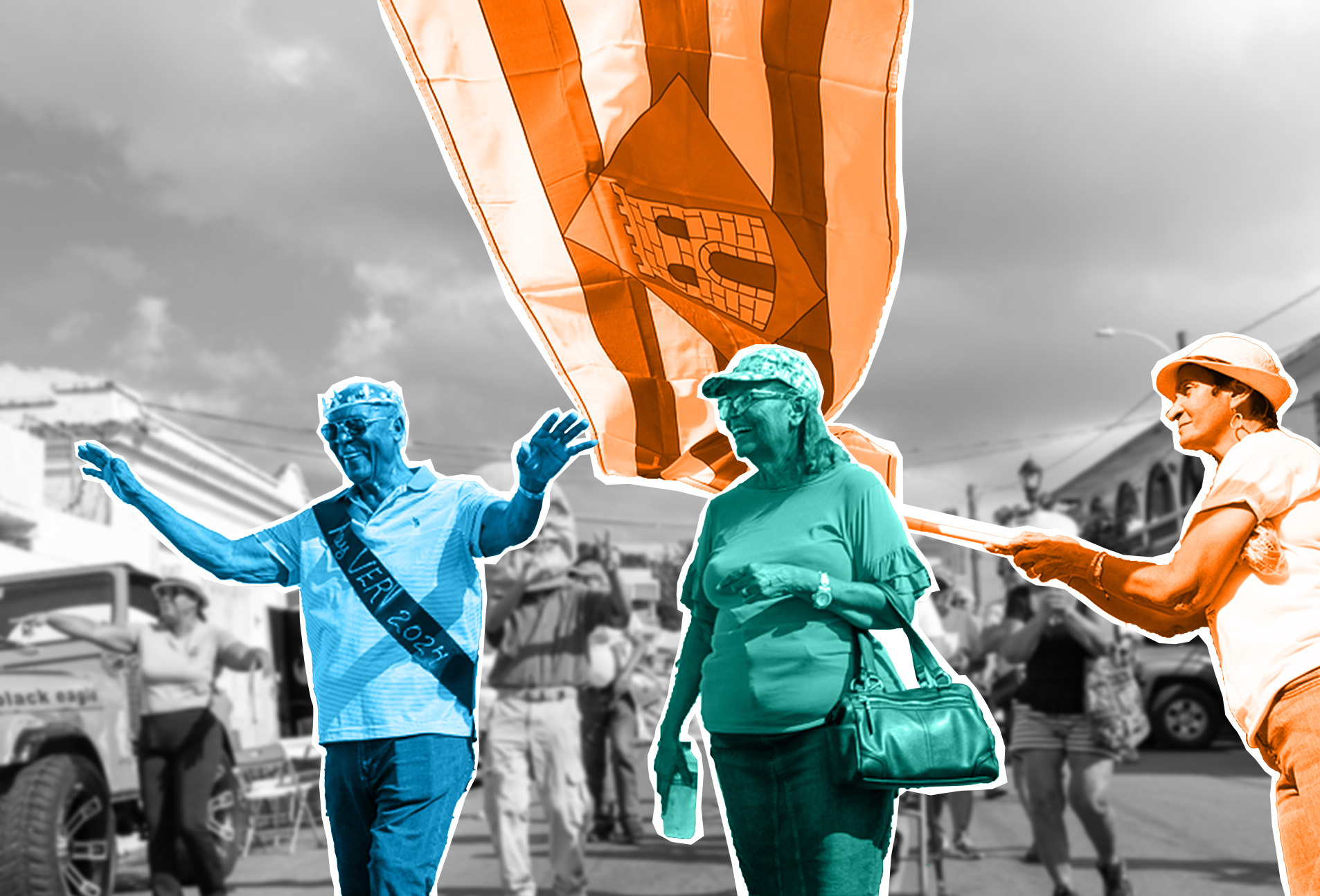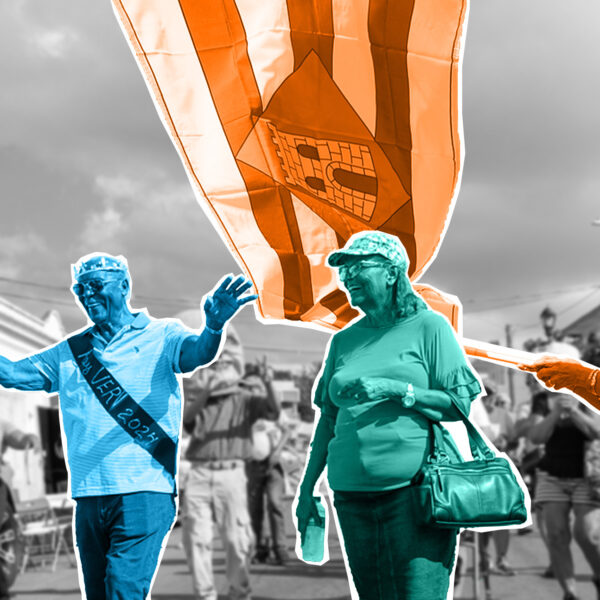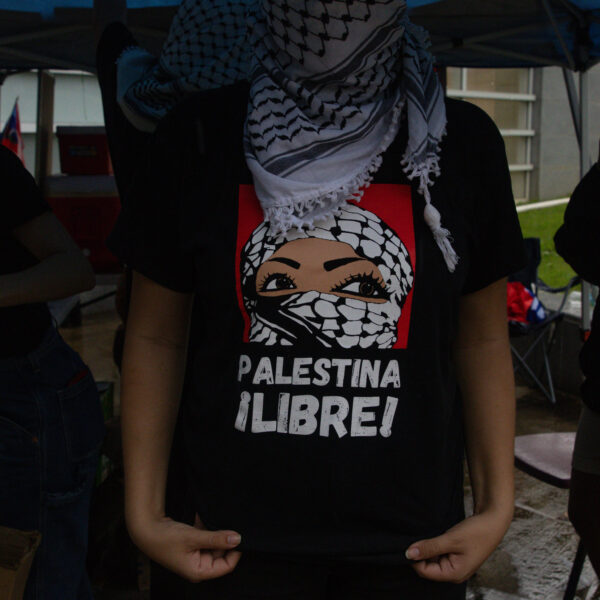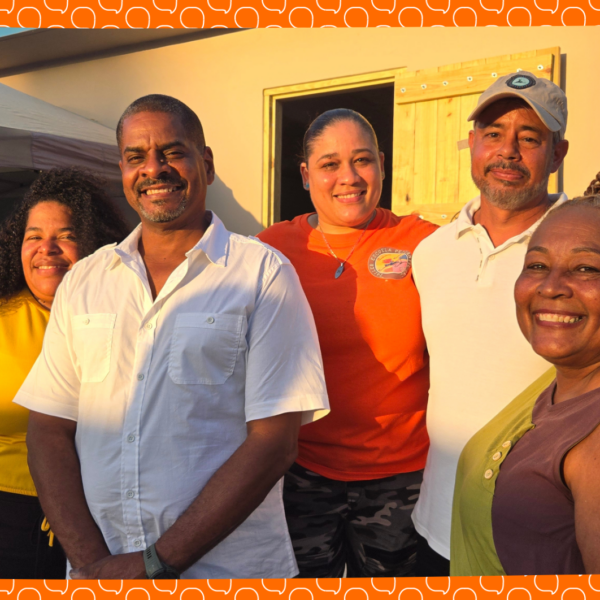
Amid lack of services, this organization is supporting cancer patients in Vieques
Vieques en Rescate offers transportation, economic and emotional support to cancer patients in the island town
This article was produced as a project for the USC Annenberg Center for Health Journalism’s 2023 Impact Fund for Reporting on Health Equity and Health Systems. 9 Millones also received mentorship and support via the Center’s engagement initiative.
VIEQUES, PR — The sun was setting above the Esperanza neighborhood in Vieques when Zaida Torres Rodríguez was kneading 12 pounds of flour with vegetable oil, water and salt. It was the day before the Vieques Arepa Festival, a celebration held on this island municipality of Puerto Rico since 2014. “Gratitude comes in many forms,” was how she summarized the act of creating arepa dough for frying: this is her way of giving back to cancer patients on her island.
But the festival is more than just a cultural event —it is a fundraiser for Vieques en Rescate (VER), an organization that, for 11 years, has offered financial and emotional support to cancer patients from the town also known as Isla Nena. If anything, the festival is a “party for the patients, survivors and their caregivers,” noted Torres Rodríguez.
The 69-year-old great-grandmother has dedicated her life to improving the health of her community, be it working as a nurse, volunteer or activist. But what began as a calling towards others is now a personal matter: multiple of her family members have had cancer, and now she is battling it herself.

Vieques and its neighboring island, Culebra, have the highest age-adjusted cancer mortality rate in Puerto Rico, according to data from 2000 to 2021 from the Puerto Rico Central Cancer Registry. In Vieques, an average of 17 people died each year, which translates to a mortality rate of 127 per 100,000 residents, whereas in Culebra, an average of 3 people died each year, which translates to a rate of 132.
Although the incidence rate in these municipalities is not the highest in the entire archipelago, access to specialized medical services remains a sea’s distance away, forcing patients to take a ferry to receive treatments such as chemotherapy.

VER addresses this need by hiring a driver who accompanies patients on the ferry ride and drives them to the hospitals on Puerto Rico’s main island, Isla Grande. The Arepa Festival helps the organization fund transportation costs. This past year, its board and volunteers raised $39,332, which represents a little more than half of its annual budget.
The origins of the festival date back to 2003, before the founding of VER, when a group of Viequenses, mostly leaders of the Viequenses Women’s Alliance, organized a Relay for Life, an event that raises money for the American Cancer Society. “We would do the activity without having a track to walk on; we would do it at Sun Bay [Beach],” Torres Rodriguez explained. The money they raised was then donated to the American Cancer Society. For the eleventh edition of the event, the organizing assembly decided to found a local entity so that all the funds would stay in Vieques.
“We know the needs of cancer patients firsthand; people can come and [at] that very moment receive help,” said Hilda Bonilla Rodríguez, parliamentary advisor of VER's Board of Directors.
Militarization and pollution
After dropping off refreshments and other donations to VER’s offices, Geigel Rosa Cruz condemned the high incidence of cancer in Vieques during an interview with 9 Millones. “We directly accuse the Navy bombing, which was indiscriminate,” said Rosa Cruz.
For 60 years, the U.S. Navy used a large part of Vieques for military exercises in which they detonated aerial and naval bombs. A study, published in 2005, showed that vegetation on the past practice range has higher levels of lead and cobalt than on the main island of Puerto Rico. The study also found higher levels of lead, nickel and cobalt in seaweed. Although the presence of metals decreased after the bombing ended in 2003, levels remained higher compared to those of the main island. Continued exposure to lead, nickel and cobalt can cause cancer, according to the Centers for Disease Control and Prevention (CDC).

Bonilla Rodríguez, who is an agricultural agent for Vieques and Culebra with the Agricultural Extension Service, also denounced that the cleanup of the area occupied by the Navy is done with open-air detonations. “With the trade winds that we have in the eastern area… That smoke runs all over Vieques and even Isla Grande as well,” she said. The Navy has denied the allegations based on air monitoring studies commissioned by the military.
The last contamination study in Vieques, conducted by the federal government —the federal Agency for Toxic Substances and Disease Registry— was conducted a decade ago, and has been widely criticized by the scientific community. That’s why the U.S. Environmental Protection Agency (EPA) opened a call in 2019 to investigate environmental issues in a way that integrates the Vieques community. A group of scientists, led by Puerto Rican professor Lorena Estrada Martínez, is conducting research to understand the history of contamination in Vieques and its impact on people, plants and animals. “We are taking samples where people told us they saw things happen,” Estrada explained, adding that communities report events that the Navy omits. The VER Parliamentary Advisor hopes that this research will shed more light on the relationship between pollution and cancer rates.
From 1995 to 1996, while the U.S. Navy was still in Vieques, incidences were 26% higher than the rest of Puerto Rico, and mortality was 35% higher, according to the Comprehensive Cancer Center and the Department of Health. Since the Navy left, incidences have decreased. The age-adjusted cancer incidence rate was around 296 cases per 100,000 people, according to data from the Central Cancer Registry, from 2000 to 2021. This rate is below the Puerto Rico average incidence rate of 309 in 100,000. However, mortality today is still above the average rate, according to the most recent data.
Viequenses' medical needs
Health services worsened in Vieques when the Susana Centeno Diagnostic and Treatment Center (CDT) closed back in 2017. The impact of Hurricane Maria caused damage to the integrity of the roof, according to a statement released by the U.S. Department of Defense. The rain, heat, and lack of electricity caused the spread of mold and fungus within the building, which created unsafe conditions for patients and doctors, according to former CDT medical director Betzaida MacKenzie. This structure was demolished in May 2022, and 18 months later, construction began on a new CDT, which will cost $88.5 million.
The government converted a community shelter and some trailers into a temporary health center for Viequenses, where dialysis, gynecology services and emergency care are now available. Vieques also has a primary health clinic, run by the non-profit HealthproMed. However, there is no delivery room, no blood bank, and no access to most medical specialists.


The biggest challenge for cancer prevention on the island municipality is the lack of mammography and CT scan services, plus treatments such as chemotherapy.
“There is a great need here for screening studies, diagnostic studies,” said Dr. Luis Delgado Mateo, medical director of the Dr. Isaac González Oncology Hospital. During the first day of the Arepa Festival, the doctor led a group of doctors and students offering orientation, screening and preventive care services to patients. “As with any disease, prevention is the most important thing,” said Delgado Mateo, who emphasized that the mortality rate depends directly on how early the disease is detected.
This is the fourth year that the Hospital Oncologico Sobre Ruedas (Spanish for Oncology Hospital on Wheels) initiative has transformed the Multi-Purpose Center in Vieques into a facility that offers mammograms, pap smears and prostate exams. They also offered consultations with dermatologists and gastroenterologists, specialists that are normally not available in Vieques.

“You literally can't do CT scans here, you can't do a lot of studies that we, at least in the oncology practice, need to do. Patients have to go to the main island,” Delgado added.
The Puerto Rico Department of Health’s Assistant Secretary for Medical and Hospital Services, Yesarel Pesante Sánchez, said in an interview with 9 Millones that the Department purchased and equipped a trailer to offer CT scans in Vieques for a cost of $1.2 million. Authorities project that it will be in service by July 2024, but chemotherapies would not be available until the construction of the infusion center within the CDT that is expected to be completed by December 2025.
The most affordable and common way to travel from Puerto Rico’s main island to Vieques is by boat. Vieques’ port is 22 km (13 miles) from Ceiba.
“The most pressing need is transportation, transportation that is safe and that they can go with caregivers,” Bonilla Rodriguez emphasized.
VER's services to the cancer patients in Vieques
During the Vieques Arepa Festival, Edwin Acosta Encarnación donned an apron to prepare skewers and BBQ burgers, which he served with arepas (instead of buns). Acosta Encarnación works as a driver for VER, but that weekend he also served as a volunteer. His friend Zaida Torres Rodríguez —whom he has so often transported to her chemotherapy appointments at the Oncology Hospital— made the dough, which he then formed into rolls, fried and sold to attendees.

The day before, he had gotten up at 4am to take one of the patients to a follow-up appointment. During the week of the Festival, Acosta Encarnacion made the same trip four times. He accompanied cancer patients during the ferry ride to Ceiba. From there, he drove them to their medical appointments, waited for them, picked them up and brought them back to Vieques. “I like to help,” he replied humbly.
The hard part, he lamented, is when they pass away: “I’ve already lost a few.”
“It’s very hard because it’s like losing a friend,” echoed VER’s secretary, Yesenia Legrand Camacho, during an interview at the organization’s offices. Legrand is in charge of maintaining the administration and managing patient relations: she greets patients, explains the services they offer and maintains their records. “I say my job is more like patient support because I have to put myself in their shoes,” she said. Although experiencing grief is difficult, she added that she has witnessed people who heal, and that is the “little light of hope” that keeps her motivated.
Acosta Encarnación and Legrand Camacho are the only employees of the non-profit organization. The board of directors all work as volunteers.
In 2023, VER supported 94 patients, including people with suspected tumors, survivors and those receiving cancer treatment, according to the organization. The number of patients they serve has nearly doubled since 2020.

The organization’s annual budget hovers around $70,000. Decisions on how to support patients are made by an evaluation committee, which is composed of the board chair, the board treasurer, two health professionals, and one person representing the community.
The entity offers a maximum of $1,500 per year to participants so they can subsidize expenses related to a cancer diagnosis. That amount can cover medical plan deductibles for the cost of therapies and medications, said VER President Sandra Inés Meléndez Rosario in an interview with 9 Millones. The total cost of treating the disease can reach up to $100,000, according to engineer Ramón González Castaing, president of the Puerto Rican League Against Cancer and its Oncology Hospital. This amount falls short of the average income of Vieques residents, which is $17,062 annually, according to the U.S. Census Bureau.
VER also donates gloves, diapers, nutritional supplements (such as Ensure and Glucerna), and gauzes.
“It's not just financial support, [it's] emotional support,” detailed Brenda Torres Acevedo, director at Maria M. Simmons Rivera Elementary School.
She recounted that when she received her breast cancer diagnosis, the VER team called her often to find out how she was feeling as she left her appointments. “That support network is so, so enormous that, at one point, you think you don’t have cancer,” she added. That support doesn’t just come in the form of calls, as the institution also fosters hope by matching survivors with patients, and holding prayer circles.
VER is sustained through grants from other organizations, the support of volunteers and the Vieques Arepa Festival, whose proceeds go entirely to this cause, Meléndez Rosario explained. Since 2017, the Rotary Club of Vieques has been one of VER’s main sponsors, followed by Direct Relief, an international nonprofit organization that has supported them since 2021. The festival generates revenue through food and beverage kiosks, the sale of T-shirts and luminaries, as well as registrations for their 5K marathon.
Ongoing challenges and opportunities for growth

Despite the support offered by VER, maritime transportation still presents a major challenge for cancer patients. Torres Acevedo pointed out the difficulty of the journey. “Getting on the ferry after receiving treatment is tough. It is hard because you are already suffering from the effects of the treatment itself,” she described.
For older adults, getting up early to guarantee a seat on the boat takes away from the rest they need to strengthen their immune system. “I have to get up, every day that I go to an appointment, at two in the morning to be able to come and take a parking space here in the town [center], and to be able to take a turn,” explained 77-year-old Victor Parrillas.
VER’s palliative service is limited. The organization has only one vehicle and a single driver, which they use for long trips to the San Juan Metro area, where most patients are treated, Bonilla Rodríguez explained. One of VER’s goals is to acquire an additional —smaller— vehicle and another driver, in order to take patients who need services in towns in the east, such as Fajardo and Humacao. The organization says it is more cost-effective to own its own vehicle. VER’s vehicle can carry up to 10 passengers at a cost of $99 per trip, while paying for private transportation costs $120 per patient.
Even with all that VER does to support patients, Meléndez Rosario is convinced that “if the way the [maritime] transportation system works doesn’t change, the suffering is going to continue.”

According to interviewed citizens, their greatest wish is “that they give us treatment in Vieques”. This sentiment was validated by at least six interviews and a simple majority (50.5%) of a survey distributed by 9 Millones during the festival, which evaluated how the health system in Vieques could be improved. Eighty percent of the 99 people surveyed rated the local health system as “poor”; 53% felt it had worsened compared to 20 years ago.

“We insisted so much so that now —every month— an oncologist comes,” Meléndez Rosario said about one of the main achievements that the organization has accomplished since the end of 2020. In 2021, Dr. Joel López Figueroa began offering clinics in Vieques as a volunteer. After noticing his availability, the Department of Health offered him a contract, which was in effect until June 2023. “I am not going to stop providing the service because that has not been given; I started as a volunteer, and I will continue to do so,” reacted the oncologist doctor in a call with 9 Millones.
Despite recurring visits, chemotherapy is not offered in Vieques due to lack of an adequate space. In VER’s offices, chairs made for chemotherapy remain untouched under a blanket. The Rotary Club of Vieques and the College of Medical Surgeons donated infusion chairs, desks, screens and stretchers to provide treatment in Vieques, but they remain unused.

“That is the challenge we are negotiating,” said Bonilla Rodríguez, “so we do not have to wait for the hospital to be built and they begin to give chemo in a sterilized trailer”.
Pesante Sánchez —the Department of Health’s liaison in Vieques— explained that the agency had obtained a provisional license from the Assistant Secretary for Regulation and Accreditation of Health Facilities (Saraf, for its Spanish acronym) to establish an oncology infusion center temporarily in a trailer, but this alternative was discarded because of the risks involved. Preparing the mixture of chemicals to be applied intravenously requires a safety cabin to extract toxic gasses. According to Pesante Sanchez, this would not be feasible to do in a trailer. The Health Department also evaluated mixing the ingredients in Fajardo and transporting the mix to Vieques, but they learned that, once prepared, it expires in 4 hours, a risk that is too costly, the official explained.
“We do not currently have a suitable space. We are operating in a provisional place, which is in compliance with the emergency room part, but this is an additional service,” answered Pesante Sanchez in response to 9 Millones’ questions. Although he mentioned that they are receptive to other alternatives, he stressed that their efforts are aimed at finishing the construction of the CDT, which will have an infusion center. “We realized that, on a trailer, we could not do it because we were not going to be in compliance… What are we doing as an administration, well, putting the effort into the construction,” he clarified.
Uncertainty also surrounds VER’s headquarters. The organization leases a municipal building on the outskirts of Isabel II Village for $1 a year. Although municipal support has always been there, for them, nothing would compare to the certainty of owning their space. “If we could have a place of our own, that we didn’t depend on negotiating, it would be great,” Bonilla said.
Two year wait for new chemotherapy center
When Governor Pedro Pierluisi announced —on May 18, 2022— the demolition of the CDT, he emphasized the following: “I am saying it loud and clear: all this construction —the new hospital—is going to be finished in 2024. Take it as a fact. There is no way [it can be delayed] because we are taking into consideration all the possible setbacks, so it will be done for sure.”
However, there were delays. On November 15, 2023, authorities laid the first stone on the grounds of the former Susana Centeno CDT. There, Pierluisi explained that the work was delayed because inflation increased costs “tremendously,” and they needed to allocate more funds for materials and labor. The total investment, according to the governor, is $88.5 million. Most of those funds come from FEMA, and are supplemented with money from the central government, CDBG-DR funds, and the municipality of Vieques.

Authorities now expect to complete the first phase by the end of 2024, which will include the construction of a dialysis center, an obstetrics and trauma room, as well as machine rooms for the electricity generating plants and water cisterns. The chemotherapy center will be built during the last phase, which is projected to be completed by the end of 2025. When asked by reporters why the services for cancer patients were left for the last phase, the governor said that “we don’t have to wait for this facility to be in place to provide that service.”
In fact, Health Secretary Carlos Mellado Lopez assured during this visit that the agency already had the permit to provide chemotherapy in Vieques. However, 9 Millones confirmed with the department that it’s a provisional permit from Saraf, whose use was discarded by the agency, given the logistical complexity of administering the mixture of chemicals, and the need for a doctor and oncology nurse.
Many of the Viequenses surveyed or interviewed by this outlet have expressed concern that the health center under construction will become a white elephant: a structure without personnel. “Where are they going to get the budget for that payroll?” asked Bonilla Rodríguez.
The Pierluisi administration estimated the operational cost of the CDT in Vieques at $8 million annually. The Fiscal Control Board —imposed by the U.S. Congress— approved subsidizing “certain costs associated with that operation,” Pesante Sanchez said. The money will initially come from the $100 million in Medicaid funds allocated by President Joe Biden. Eventually, the local government plans to increase revenues by increasing the number of patients and services billed to private health plans, as well as with changes to billing guidelines in the government’s health program.
A broader vision
Ever since Hurricane Maria struck Puerto Rico, VER’s management team has dreamed and pursued the resources to offer chemotherapies on Isla Nena.
“We have not been able to do it. Bureaucracy eats away at the system, and the promises fall flat. Let people know that there is no chemotherapy here,” Bonilla Rodriguez emphasized.
The activist and volunteer added that some patients do not want to go through the chemo process to avoid the constant trips. “Many prefer not to start treatment, and that is a person who has already ‘given up,’ and it is very sad because this is happening to us every day. Every day,” she lamented. VER’s dream is that cancer treatment services will be offered in Vieques soon. “It’s uphill, but we don’t give up,” she added.
Part of the problem lies in the mentality that it is impossible to have specialists for a population of 8,249 residents, said the VER President. In Meléndez Rosario’s opinion, health services in Vieques could serve a larger population than the one that resides in the island municipality. The former hospital administrator at Susana Centeno delivered a transition report in December 2022, in which she highlighted the potential of expanding dialysis services to patients from the U.S. Virgin Islands, who travel to Florida to receive this treatment, as an opportunity.

If there was an efficient maritime transportation service, people from Puerto Rico and the Virgin Islands could receive medical services in Vieques and “enjoy my island,” Meléndez Rosario said as she pointed to the Caribbean Sea, which can be seen in the distance from the hill where she lives.
“Don’t keep segregating Vieques and Culebra from the rest of Puerto Rico, because we are Puerto Rico.”
Download a PDF copy of this article to share in health clinics and community centers!
If you’re a media outlet that wants to republish this article, please reach out to info@9millones.com


